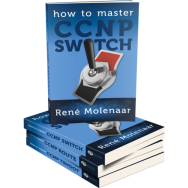Scenario:
After waking up from cryosleep the year appears to be 2020 and there is not a single IPv4 address left on the planet. The last thing you remember are the stories about the end of IPv4 and the migration plans for IPv6…now it seems this is all reality! It’s up to you to configure OSPFv3 and make the network operational…resistance is futile 😉
Goal:
- You are not allowed to use IPv4 addresses.
- You are not allowed to use any IPv6 global unicast addresses except the ones on the loopback interfaces.
- Use the MAC-address for the last 64 bits of the IPv6 addresses required for the FastEthernet links.
- Configure OSPFv3 and achieve full connectivity between the networks on the loopback interfaces.
It took me 1000s of hours reading books and doing labs, making mistakes over and over again until I mastered all the routing protocols for CCNP.
Would you like to be a master of routing too? In a short time without having to read 900 page books or google the answers to your questions and browsing through forums?
I collected all my knowledge and created a single ebook for you that has everything you need to know to become a master of routing.
You will learn all the secrets about IPv6, OSPFv3, routing and more.
Does this sound interesting to you? Take a look here and let me show you how to Master CCNP ROUTE
IOS:
c3640-jk9s-mz.124-16.bin
Topology:

Video Solution:
Configuration Files
You need to register to download the GNS3 topology file. (Registration is free!)Once you are logged in you will find the configuration files right here.

The How to Master series helps you to understand complex topics like spanning-tree, VLANs, trunks, OSPF, EIGRP, BGP and more.
Written by René Molenaar - CCIE #41726


Dear:
kindly complete the rest of of the IPV6 with video solution
Not probably the best idea to have overlapping subnets in loopback interfaces.
@Kaage you are so right……stupid mistake ;D just fixed it by using /128 for the loopbacks.
Great! Thanks for the help Renee.
I actually did some additional experimenting with this lab to answer some questions that I had. But I have one more:
Is it natural for dynamically learned routes to use link-local addresses as next hops? I actually configured some global addresses on the f0/0 interfaces between Vulcan and Romulan but the routing table still had link-local next hop addresses for the loopbacks. Is this a natural thing? It still works, but I was just curious.
Hello Fliprich,
Good question. IPv6 uses link-local addresses for the next hop so the behavior you see is normal. This means you don’t need any global unicast IPv6 addresses anymore on point-to-point links.
Great Lab.
Thanks Rene.
Thanks!